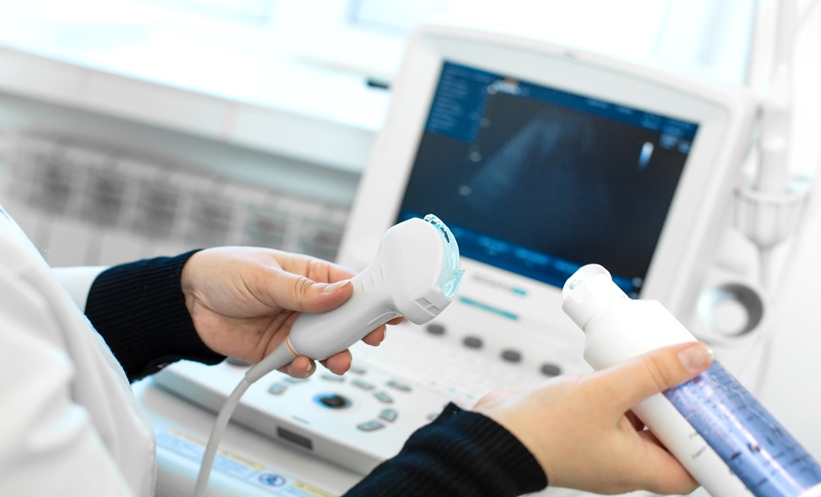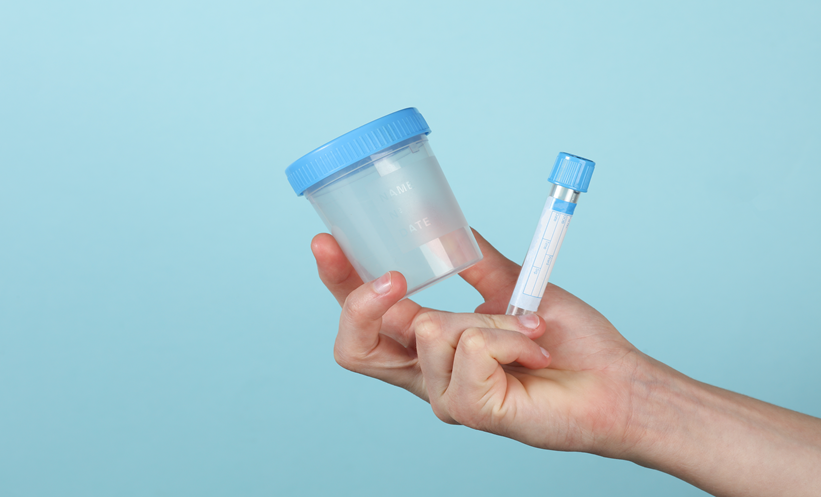Authors: Christopher Chapple,1,2,3,4 Arnulf Stenzl5,6
1. Consultant Urological Surgeon, Sheffield Teaching Hospitals NHS Foundation Trust, South Yorkshire, UK
2. University of Sheffield, South Yorkshire, UK
3. Sheffield Hallam University, South Yorkshire, UK
4. Secretary General, European Association of Urology (EAU)
5. Secretary General Adjunct, European Association of Urology (EAU)
6. Chairman of Urology, University of Tübingen Medical Center, Germany
*Correspondence to [email protected]
Citation: EMJ Urol. 2022;10[1]:18-24. DOI/10.33590/emjurol/10185487. https://doi.org/10.33590/emjurol/10185487.
EARLY BIRD CATCHES THE WORM
Day 1 was set in motion at 07:30 a.m. with the delivery of four Game Changing sessions (Figure 1). James Catto gave his conclusions on the ‘Effect of robot-assisted radical cystectomy with intracorporeal urinary diversion vs. open radical cystectomy among bladder cancer patients: a randomised clinical trial’ (Figure 2). He stated that participants undergoing complete robotic radical cystectomy spent statistically significantly more time out of the hospital than those receiving open surgery.
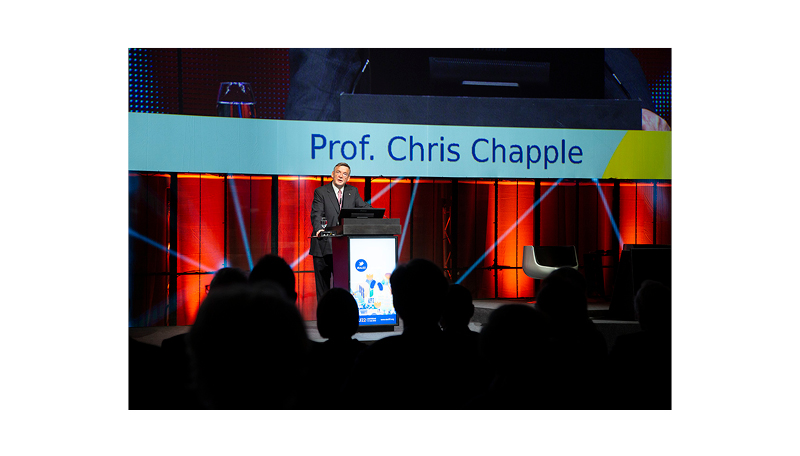
Figure 1: Christopher Chapple welcoming all the attendees to the Annual European Association of Urology (EAU) 2022.
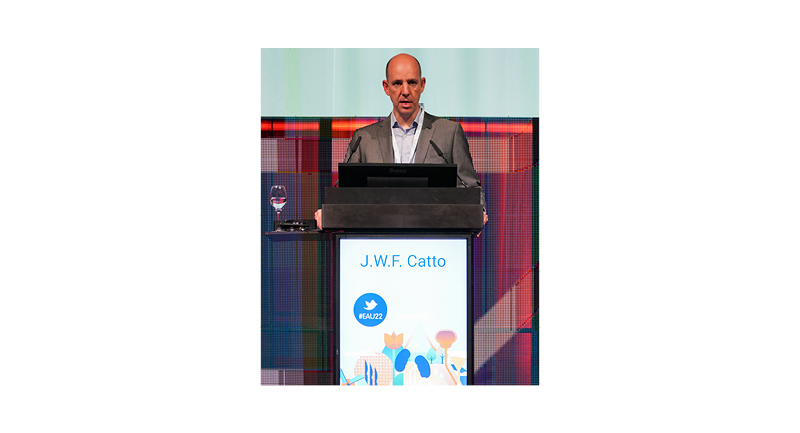
Figure 2: James Catto delivering a session on the effect of robot-assisted radical cystectomy with intracorporeal urinary diversion versus open radical cystectomy among patients with blood cancer.
Marc-Oliver Grimm shared his presentation on the ‘Complications with open versus robotic-assisted partial nephrectomy (OpeRa) in patients with intermediate/high complexity kidney tumours’. He concluded that the 30-day complication rate (primary outcome) was numerically lower with robot-assisted partial nephrectomy than open partial nephrectomy.
Thomas Powles shared promising 30-month disease-free survival benefit with adjuvant pembrolizumab in KEYNOTE-564 study, and André Deschamps highlighted results from EUPROMS 2.0, the importance of active surveillance, and shared decision-making for the treatment of prostate cancer.
VISIBLE HAEMATURIA CASE
Plenary Session 1 began with Teele Kuusk introducing a patient case of a 58-year-old female with a small renal mass centred on bilateral cT1 in her presentation, ‘Challenges in renal cancer’. This was followed by expert lectures on various treatment approaches and sequences addressing the case.
Alessandro Volpe said that renal tumour biopsies (RTB) can support treatment decisions for cT1 renal masses. In his presentation ‘When do we perform biopsy?’, he stated that the added value of RTBs is significant in the setting of bilateral tumours, especially in older patients and patients with less than three renal masses. In addition, RTBs are safe and should be proposed especially when different treatment approaches, including active surveillance, are reasonable options. Volpe added that genetic and molecular characterisation beyond traditional histology on RTBs will have the potential to further optimise patient decision making.
VIRAL CONCERNS
The lessons we have learnt during the COVID-19 pandemic, including its impact on urological care, as well as urological research, and a call to action in the elimination of human papillomavirus (HPV)-related cancers, are some of the topics that were covered during Plenary Session 2. Experts Oscar Brouwer and Florian Wagenlehner chaired this highly informative session.
In his presentation ‘Large simple trials after the COVID-19 pandemic: lessons learnt for urology research’, Kari Tikkinen discussed the need for better evidence-based research. His take home message was: “Trials need to be as large as possible, as simple as possible, practical with minimal trouble, and deliver patient important outcomes.”
Daniel Kelly, Co-Chair of the European Cancer Organisation (ECO) HPV Action Network, delivered his pre-recorded lecture on ‘Eliminating HPV-related cancers: a call to action’. “HPV is largely preventable, yet it is the fourth most common cancer in some areas of Europe. We need to all be involved, and urologists have a role to play in HPV prevention, not just in dealing with the consequences,” he said.
LIVE SURGERY AND LIVELY DEBATE
Day 2 had a strong surgical theme, beginning with the ‘Nightmare Session’, which presented several challenging cases during Plenary 3. Of note was the case of a ruptured kidney tumour, and the intense debate proceeding this between Andrea Minervini and medical lawyer Bertie Leigh. This was an in depth and thought-provoking cross-examination.
In the afternoon, the ‘Meeting of the EAU Section of Uro-Technology (ESUT) in cooperation with ERUS and EULIS’ (the EAU Sections of Robotic Urology and Urolithiasis, respectively), held a 7-hour ‘live surgery session’, which is always a highlight at every Annual Congress (Figure 3A and 3B).
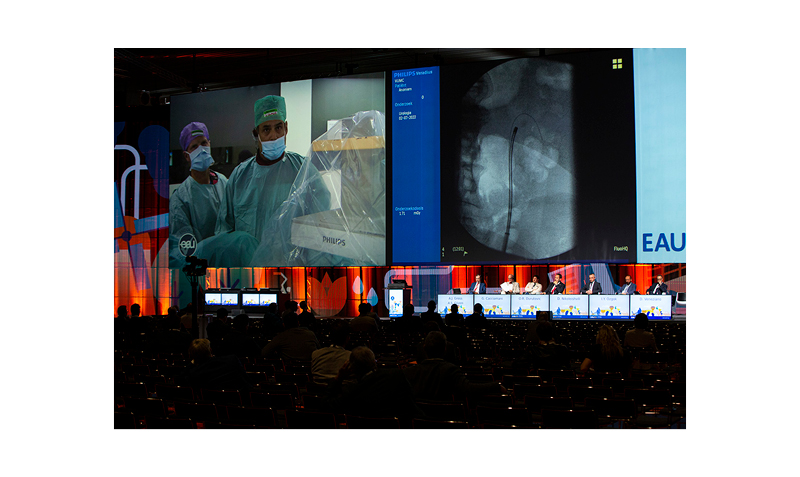
Figure 3A: Live and lively debate on Day 2 of European Association of Urology Congress (EAU) 2022.
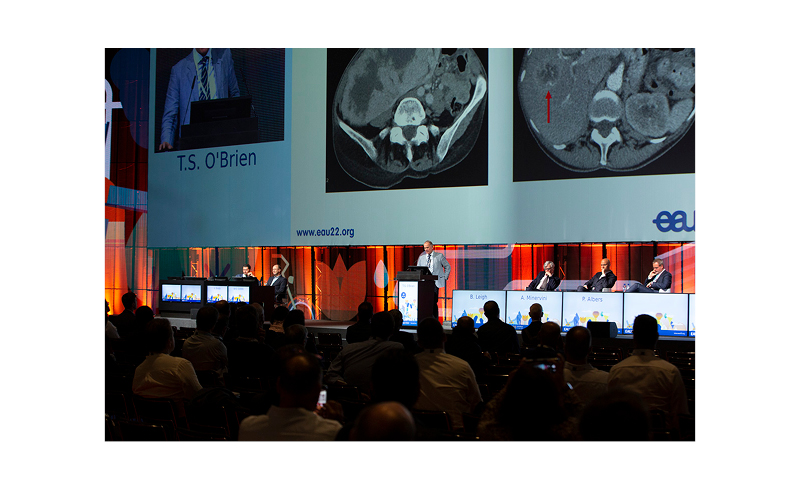
Figure 3B.
Patricia Zondervan demonstrated a 3D laparoscopic radical nephrectomy on a ‘sticky’ older female patient, leading to some discussion with the panel on the choices of her approach and also her preference for 3D laparoscopy, even for radical nephrectomy: “Especially combined with 4K, I find 3D offers a clear advantage over 2D.”
The eURO Auditorium then switched focus to Henk Van Der Poel and his robotic-assisted prostatectomy with sentinel lymph node mapping. The use of indocyanine green under near-infrared light, combined with radioactive tracer and the Crystal Probe (Cygnus Instruments, Dorchester, UK) device made it a relative breeze to find the sentinel nodes.
STATE-OF-THE- ART LECTURES
The presentation ‘Landscape of current trials with intravesical treatment in high-risk BCG [Bacillus Calmette–Guérin]-naïve NMIBC [non-muscle invasive bladder cancer]’ by Ashish Kamat kickstarted Plenary Session 4. During his lecture, he underscored that for the purpose of clinical studies, all high-grade tumours should be considered high-risk. “This is not to take away from the EAU Guidelines classification, which is good for counselling patients,” said Kamat.
In his lecture ‘Lynch syndrome: what urologists need to know’, Morgan Rouprêt stated that Lynch syndrome is the most common familial cancer syndrome, first described by Aldred Warthin in 1895.
In identifying Lynch syndrome in patients, Rouprêt mentioned the Bethesda criteria to test tumour for microsatellite instability, which included colorectal cancer in a patient who is younger than 50 years old, and presence of synchronous or metachronous syndrome-associated tumours regardless of age, to name a few. In addition, he mentioned the Amsterdam criteria, which involved a patient’s three relatives with a Lynch syndrome-associated cancer (e.g., colorectal cancer, endometrial, etc.), wherein one is a first-degree relative of the other two, and at least two successive generations are affected; and other indicators.
MORE BREAKING NEWS
Day 3 began with several Game Changing presentations. On behalf of his team, Declan Murphy shared encouraging initial trial results for LuTectomy, stating: “Neoadjuvant Lu-PSMA is safe, effective, and surgery is very straightforward”. The session followed with Steven Joniau presenting updates on the ARNEO trial in ‘Randomised Phase II trial of neoadjuvant degarelix with or without apalutamide prior to radical prostatectomy for unfavourable intermediate- and high-risk prostate cancer’. He concluded that degarelix plus apalutamide achieved better tumour response, PSMA PET SUVmax after neoadjuvant therapy predicts pathological response, and phosphatase and tensin homologue loss is a negative predictor of minimal residual disease.
HOW USEFUL IS MRI?
There were plenty of scientific updates and even more lively debate in Plenary 5 on high-risk local treatment for prostate cancer. Experts Alberto Bossi and Alberto Briganti chaired this highly informative morning.
In Giorgio Gandaglia’s state-of-the-art lecture ‘How does MRI change the local strategy in high-risk men? – Surgery’, he stated that MRI in high-risk patients is important to provide the prognostic information to guide the delivery of tailored surgical approaches; to identify nerve-sparing candidates; and to identify patients who should receive wider excision.
According to Gandaglia, MRI does have an impact on changing surgical plans in the rising risk category by up to 52%, and the surgical decision-made based on MRI was correct on average in 91% of the high-risk group.
NEW MINI-SLING TRIAL RESULTS
During a Game Changer session Mohamed Abdel-Fattah presented the recent results of the Single Incision Mini-Slings versus Standard Synthetic Mid-Urethral Slings in the Surgical Management of Stress Urinary Incontinence in Women (SIMS RCT). The percentage of patients reporting success remained similar in the two groups at the 3-year follow-up. The trial will continue up to the 10-year mark.
At discussion time, Chris Chapple made it clear that that the results of the trial were welcomed. Chapple complimented the trial as “the benchmark in a market where slings are introduced with little or no research or trials.”
Delegates then had an update on the ALTAR trial from Christopher Harding with his Game Changer presentation ‘Alternative to prophylactic antibiotics for the treatment of recurrent urinary tract infections in women: multicentre, open label, randomised, non-inferiority trial’. He concluded that non-antibiotic prophylactic treatment with methenamine hippurate might be appropriate for women with a history of recurrent episodes of urinary tract infections, informed patient preferences, and antibiotic stewardship initiatives, given the demonstration of non-inferiority to daily antibiotic prophylaxis seen in this trial.
Plenary Session 6 covered the topic of personalised surgical management of lower urinary tract symptoms and benign prostatic obstruction, which included lectures on all of the available surgical options from resection to vaporisation, and novel techniques like the temporarily-placed urethral opening system. The session ended with a panel discussion between the 11 experts, weighing the merits of the huge variety of approaches available to urologists in 2022.
UPDATES ON PROPEL AND ARASENS TRIALS
Noel William Clarke launched Game Changing Session 5 with his lecture ‘Exploratory endpoints from PROpel: a Phase III trial of abiraterone + olaparib vs. abiraterone + placebo in 1st line metastatic castration-resistant prostate cancer’, wherein he provided the findings of the trial.
In the next presentation, ‘Overall survival (OS) by circulating tumour DNA (ctDNA) status in patients with post-operative muscle-invasive urothelial carcinoma (MIUC) treated with atezolizumab (atezo): update from IMvigor010’, Jürgen Gschwend shared that with longer follow-up since the interim analysis, ctDNA-positive status continued to identify patients at high risk of relapse who have improved overall survival with atezolizumab in contrast to observation.
The ‘Overall survival with darolutamide versus placebo in combination with androgen-deprivation therapy and docetaxel by stratification factors in the Phase 3 ARASENS trial’ update was presented by Bertrand Tombal, and the ‘Phase III study comparing diagnostic accuracy of mpMRI prostate to 18F-DCPyL PSMA PET/CT’ results were shared by L.M. Wong. He stated that multi-parametric MRI of the prostate remains first line for now, and has a better diagnostic accuracy to detect any prostate cancer.
ALL FACETS OF STONE SURGERY
Some of the stone-related topics covered in Session 8 were the use of access sheaths in children, devising the ‘perfect’ algorithm for a follow-up schedule for stone disease, and several case discussions that served to highlight different approaches and different instruments.
A potentially promising new technology was presented by Jonathan Harper, the burst wave extracorporeal shock wave lithotripsy, which uses ultrasound pulses instead of shock waves. This new technology might allow for shorter and in-office procedures. The first careful conclusions from Harper, based on the initial series of in-human tests, were that comminution was effective with only minimal safety concerns, and that the treatment was well-tolerated and effective.
EAU SPECIALITY SESSION: ‘THE BEST OF EAU22’
On the afternoon of Day 4, an EAU Specialty Session on the ‘Best of EAU22’ was held, with a panel of experts sharing condensed summaries on 11 topics covering important research and data. This gave delegates an opportunity to a highly concentrated dose of the EAU22 scientific programme.
References
- European Association of Urology (EAU). EAU22 Annual Congress, 1-4 July, 2022. Available at: https://resource-centre.uroweb.org/resource-centre/eau22. Last accessed: 5 July 2022.


